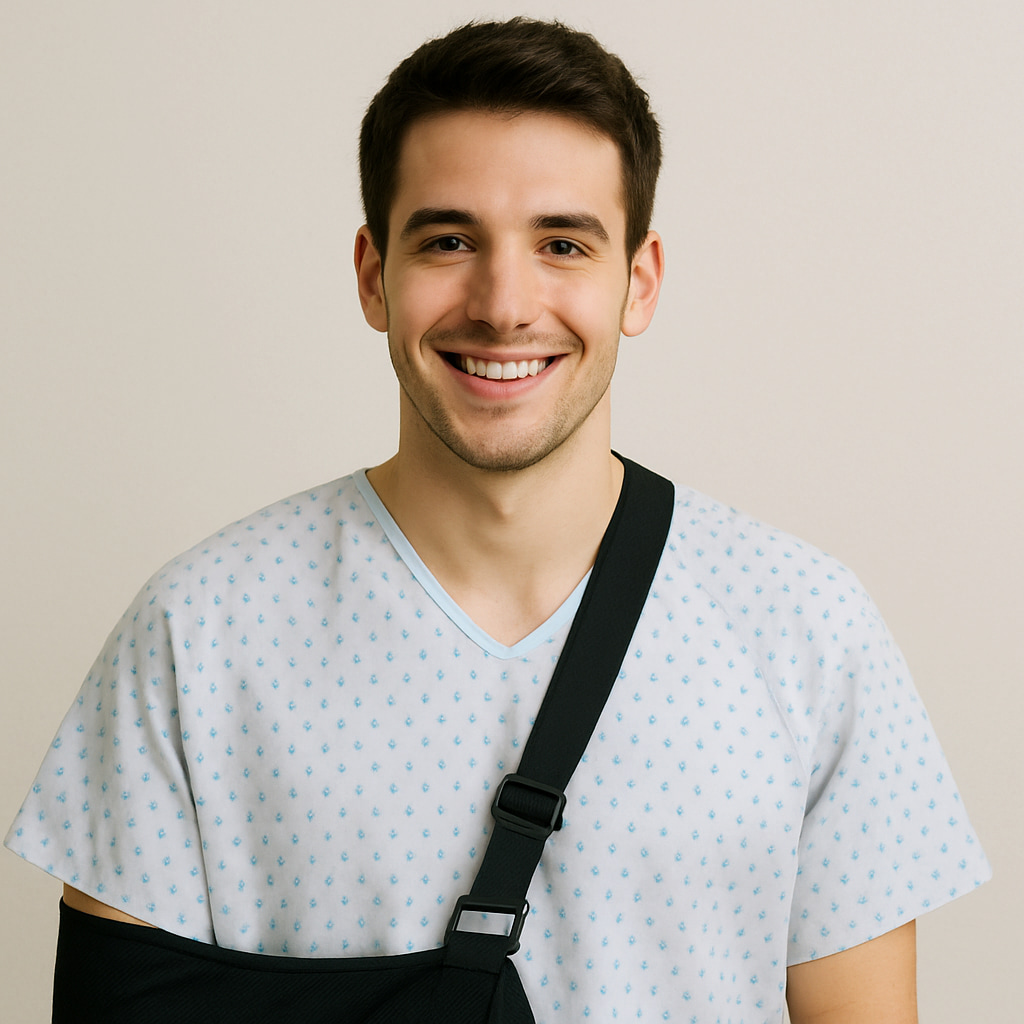See Also:
Rehabilitation Goals
- Protect the surgical repair and graft site
- Gradually restore range of motion (ROM)
- Regain shoulder strength and stability
- Safely return to daily activities and sports
- Prevent complications such as stiffness, re-dislocation, or graft failure
Expected Recovery Time
| Milestone | Timeframe |
|---|---|
| Sling use | 3–6 weeks |
| Passive range of motion | By 4–6 weeks |
| Active-assisted ROM | 6–8 weeks |
| Full active ROM | 10–12 weeks |
| Strengthening phase begins | 8–12 weeks |
| Return to light sports/training | 4–6 months |
| Return to contact sports | 6–9 months |
Phase 1: Early Post-op (0–2 weeks)
Goals
- Protect surgical site
- Manage pain and inflammation
- Prevent shoulder stiffness in adjacent joints
Instructions
- Wear sling at all times (even during sleep)
- Ice shoulder 3–5 times/day for 15–20 minutes
- Keep incisions dry and clean
- Begin hand, wrist, and elbow mobility exercises
Exercises
- Hand gripping exercises
- Elbow flexion/extension (with arm at side)
- Pendulum exercises (gentle, no shoulder activation)
- Scapular setting (retraction) exercises
Phase 2: Protected Passive Motion (2–6 weeks)
Goals
- Gradual increase in passive range of motion
- Maintain stability of the shoulder
- Continue pain and swelling management
Instructions
- Continue sling use, may remove for hygiene and exercises
- Avoid shoulder extension or external rotation past neutral
- Do not lift objects or bear weight with operated arm
Exercises
- Passive shoulder flexion to 90° (under therapist guidance)
- External rotation in neutral to ~30°
- Supine passive abduction to 60°
- Continue elbow, wrist, hand mobility and scapular activation
Phase 3: Active Motion and Early Strength (6–12 weeks)
Goals
- Restore full passive and initiate active ROM
- Begin light strengthening without stressing graft
- Normalize shoulder mechanics
Instructions
- Discontinue sling use as advised by surgeon
- Avoid sudden or forceful movements
- Monitor for signs of instability or overuse
Exercises
- Active-assisted ROM in all planes (progress to active ROM)
- Gentle isometric strengthening (rotator cuff, deltoid)
- Closed-chain scapular stabilization exercises
- Use pulley systems or wand for assisted motion as needed
Phase 4: Strengthening and Control (3–6 months)
Goals
- Improve muscular strength and endurance
- Enhance neuromuscular control and shoulder coordination
- Progress toward functional activities
Instructions
- Gradually reintroduce heavier tasks as tolerated
- Avoid overhead lifting early in this phase
- Continue to protect graft with appropriate mechanics
Exercises
- Resistance band strengthening for rotator cuff and scapular muscles
- Light dumbbell strengthening (no overhead until 4+ months)
- Proprioceptive drills (e.g., ball stabilization on wall)
- Initiate functional closed-chain activities
Phase 5: Return to Sport/Activity (6+ months)
Goals
- Restore full shoulder strength, range, and function
- Safely return to work or sport-specific training
- Ensure graft incorporation and shoulder stability
Instructions
- Follow clearance from surgeon and physiotherapist before sports
- Emphasize technique and form during sport drills
- Return to contact sports only after clinical and radiographic confirmation
Exercises
- Plyometrics (e.g., medicine ball throws, push-ups)
- Sport-specific drills (e.g., throwing, tackling mechanics)
- High-level proprioceptive and reaction-time training
- Progressive weight training with overhead components
When to Contact Your Surgeon
- Signs of infection (redness, swelling, wound discharge, fever >38°C)
- Severe or increasing pain not managed by medication
- Loss of sensation or significant weakness in the arm
- Recurrent shoulder dislocation or a feeling of instability
- Inability to move the shoulder or worsening range of motion
Disclaimer:
This is a general guideline. Your physiotherapist or Dr Lambers may adjust the protocol based on your specific condition and progress.
